"Blue Boy" is getting a long-awaited makeover, and the public can watch as one of the world's most recognizable paintings gets a little nip here, a nice tuck there and some splashes of fresh paint (blue presumably) just in time for the eternally youthful adolescent to mark his 250th birthday.
Thomas Gainsborough's stunning oil on canvas featuring a British youth dressed nearly all in blue has been one of the most sought-out attractions at Southern California's Huntington Library, Art Collections and Botanical Gardens since its arrival in 1921.
Click to Gallery
"Blue Boy" is getting a long-awaited makeover, and the public can watch as one of the world's most recognizable paintings gets a little nip here, a nice tuck there and some splashes of fresh paint (blue presumably) just in time for the eternally youthful adolescent to mark his 250th birthday.
All that begins to stop Saturday when The Huntington's senior paintings conservator, Christina O'Connell, goes to work armed with an array of 21st century tools to restore an 18th century masterpiece.
As O'Connell toils in the same area where "Blue Boy" has hung for nearly a century, visitors will be able to walk up and watch what she's doing. And, during occasional breaks, she'll stop to explain it to them.
Although Gainsborough, one of the greatest British painters of the 18th century, is renowned as a master of the brush, O'Connell says she won't be nervous while a crowd watches her every move when she takes up her own brush to add touches — inpainting, it's called — to replace what the painting has lost to the ravages of time.
Art historians have never figured out exactly who "Blue Boy" was, although they have a pretty good suspect, said Melinda McCurdy, The Huntington's associate curator for British art and O'Connell's partner in the restoration project.
But it hasn't had a substantial restoration in at least 97 years, and over time it's become a bit torn and tattered, some of its colors have faded and, worse still, some of its paint is beginning to flake.
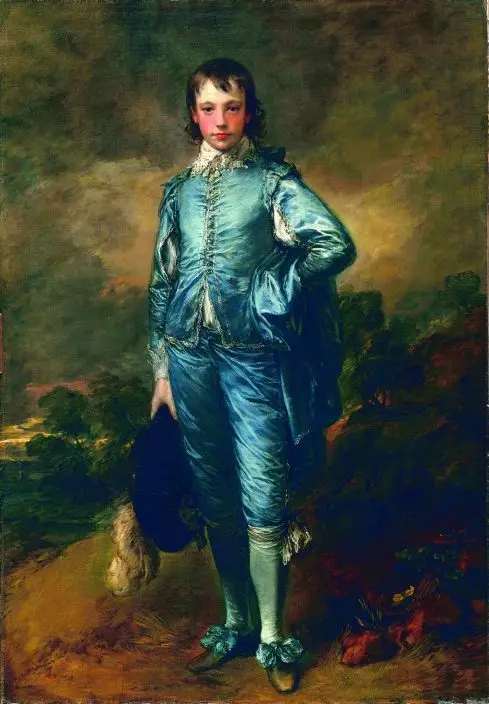
In this undated photo released by the The Huntington Library, Art Collections, and Botanical Gardens shows an oil on canvas painting titled "The Blue Boy" (ca. 1770), by Thomas Gainsborough (1727-1788). Beginning Saturday, Sept. 22, 2018, visitors to The Huntington Library, Art Collections and Botanical Gardens in San Marino, Calif., can see conservator Christina O'Connell repair Thomas Gainsborough's priceless portrait of a boy dressed all in blue. (The Huntington Library, Art Collections, and Botanical Gardens via AP)
All that begins to stop Saturday when The Huntington's senior paintings conservator, Christina O'Connell, goes to work armed with an array of 21st century tools to restore an 18th century masterpiece.
She'll have a microscope that, at 6 feet (1.8 meters), is taller than she is and can zoom in on the painting's smallest details and magnify them 25 times. She'll have numerous digital X-radiography and infrared reflectography images of the work that she's been compiling and studying over the past year. And, of course, there will be paint created to match what Gainsborough was using circa 1770.
With all that at her disposal she expects to have "Project Blue Boy" completed about this time next year and the kid back on The Huntington's Thornton Gallery wall, alongside other stunning portraits from the era, sometime in early 2020.
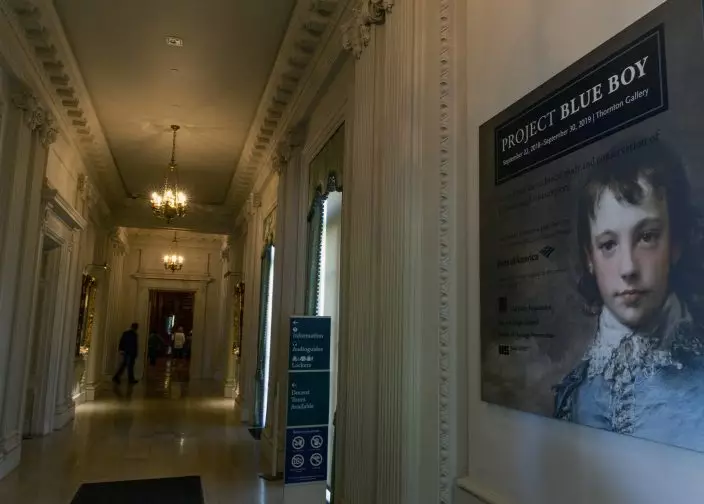
In this Thursday, Sept. 20, 2018, photo Christina O'Connell shows a x-ray display of the "The Blue Boy" painting, made around 1770 by the English painter Thomas Gainsborough (1727-1788), on display at the "Project Blue Boy" exhibit in the Thornton Portrait Gallery at The Huntington in San Marino, Calif. Beginning Saturday, Sept. 22, visitors to The Huntington Library, Art Collections and Botanical Gardens can see conservator Christina O’Connell repair Thomas Gainsborough’s priceless portrait of a boy dressed all in blue. (AP PhotoDamian Dovarganes)
As O'Connell toils in the same area where "Blue Boy" has hung for nearly a century, visitors will be able to walk up and watch what she's doing. And, during occasional breaks, she'll stop to explain it to them.
"One of the reasons why the painting hasn't undergone such an extensive conservation treatment before was because people always wanted to keep it on view. So this is a way to address the conservation needs of the painting while keeping it on view — so the visitors won't miss him," she said with a smile as she took a break from her work in the gallery earlier this week.
Indeed, "Blue Boy" — whoever he was — has become a worldwide icon since Gainsborough put him on display to acclaim at Britain's Royal Academy exhibition of 1770. The artist titled the work, "A Portrait of a Young Gentleman," but when stunned viewers saw the full-length portrait of an adolescent dressed all in bright blue silk, from his tunic to the breeches extending just below his knees, they quickly gave him a nickname.
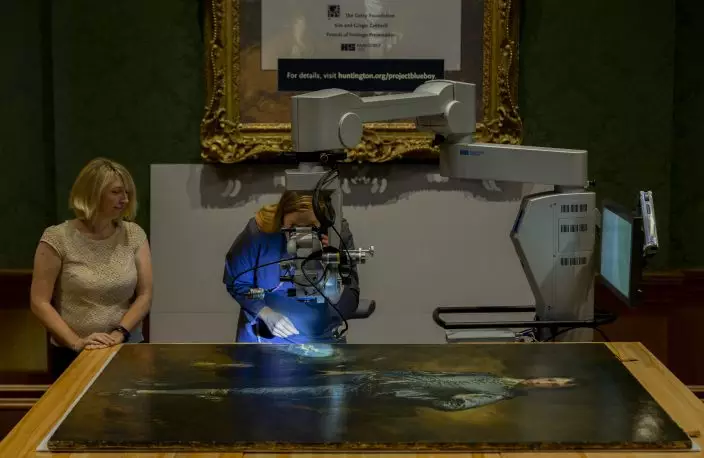
In this Thursday, Sept. 20, 2018, photo The Huntington's senior paintings conservator, Christina O'Connell, right, examines "The Blue Boy" painting, made around 1770 by the English painter Thomas Gainsborough (1727-1788), through a Haag-Streit surgical microscope at "Project Blue Boy" exhibit in the Thornton Portrait Gallery at The Huntington in San Marino, Calif. At left, is Melinda McCurdy, Associate Curator, British Art. (AP PhotoDamian Dovarganes)
Although Gainsborough, one of the greatest British painters of the 18th century, is renowned as a master of the brush, O'Connell says she won't be nervous while a crowd watches her every move when she takes up her own brush to add touches — inpainting, it's called — to replace what the painting has lost to the ravages of time.
"We're dealing with a lot of the usual suspects when it comes to a painting this age as far as condition issues are concerned," she said, adding she's repaired much worse, including a painting that was once handed to her in pieces.
Still, this is "Blue Boy" so she'll take her time. When The Huntington's founder, railroad tycoon Henry Huntington, bought it in 1921, he paid a then-record sum of $728,000. Some Britons were reported to have cried when they learned their boy was leaving his native country.

In this undated photo released by the The Huntington Library, Art Collections, and Botanical Gardens shows an oil on canvas painting titled "The Blue Boy," (ca. 1770) by Thomas Gainsborough (1727-1788). The digital x-radiography shows a dog previously revealed in a 1994 x-ray. Beginning Saturday, Sept. 22, 2018, visitors to The Huntington Library, Art Collections and Botanical Gardens in San Marino, Calif., can see conservator Christina O'Connell repair Thomas Gainsborough's priceless portrait of a boy dressed all in blue. (The Huntington Library, Art Collections, and Botanical Gardens via AP)
Art historians have never figured out exactly who "Blue Boy" was, although they have a pretty good suspect, said Melinda McCurdy, The Huntington's associate curator for British art and O'Connell's partner in the restoration project.
"It could be an image of Gainsborough Dupont, who was the artist's nephew," McCurdy said. "He lived with the family so he would have been a readily available model. And we know that the blue suit was a studio prop that the artist owned."
Dupont, looking a few years older than "Blue Boy," but not that much different, appears in the same suit in other Gainsborough paintings.
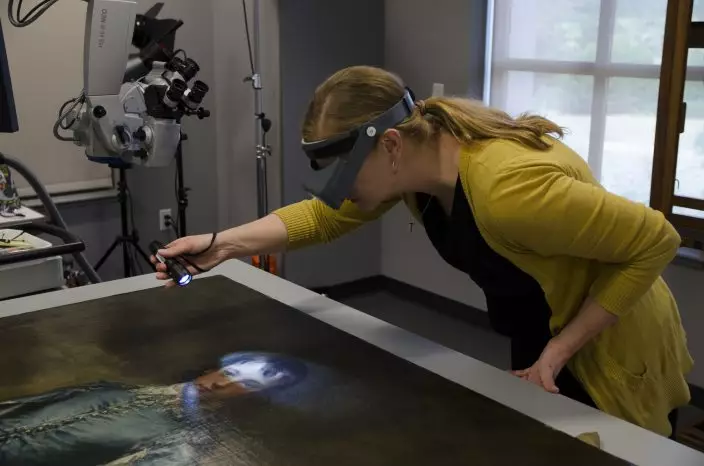
In this Aug. 31, 2017, photo released by the The Huntington Library, Art Collections, and Botanical Gardens, Senior Paintings Conservator, Christina O'Connell, wears a magnifying optivisor, as she uses a small light, held at a low angle, to illuminate the surface texture of the portrait of "The Blue Boy" during a three-month conservation study at the conservation lab at The Huntington Library, Art Collections, and Botanical Gardens in San Marino, Calif. Beginning Saturday, Sept. 22, 2018, visitors to The Huntington Library, Art Collections and Botanical Gardens in San Marino, Calif., can see conservator Christina O'Connell repair Thomas Gainsborough's priceless portrait of a boy dressed all in blue. (The Huntington Library, Art Collections, and Botanical Gardens via AP)
"Blue Boy," it turns out, also had a dog until Gainsborough painted it out of the picture. The kid's furry friend was discovered in a 1994 X-ray that also is on display at O'Connell's work station, along with X-rays that reveal nearly a foot-long tear in the canvas that was repaired so well it can't be seen with the naked eye.
What can be seen was when the tear was fixed, it was painted over with a color that didn't quite match the original. O'Connell plans to fix that.
She'll leave out the dog, however. You can still see its front paws, which Gainsborough cleverly turned into rocks when he blended the rest of the canine into the landscape.
"Composition choice, really," McCurdy speculates on the artist's reasons for sacking the pooch.
"If the white fluffy dog was there in the painting you'd spend a lot of attention on it rather than looking at the figure of the boy."
The boy is indeed what many who visit The Huntington's picturesque grounds come to see, along with the institution's gardens filled with 15,000 varieties of plants, its library containing nearly a half-million rare books and its hundreds of other priceless paintings and sculptures.
Which is why, says McCurdy, it's important that people see the care, which isn't cheap or easy, that must be taken to maintain such objects.
"We're not just a building with pretty things on the wall," she says. "We take care of them. We preserve them for the future."
VENICE, Italy (AP) — Under the gaze of the world’s media, the fragile lagoon city of Venice launched a pilot program Thursday to charge day-trippers a 5-euro (around $5.35) entry fee that authorities hope will discourage visitors from arriving on peak days and make the city more livable for its dwindling residents.
Visitors arriving at Venice's main train station were greeted with large signs listing the 29 dates through July of the plan's test phase, as well as new entrances separating tourists from residents, students and workers.
Stewards were on hand to politely guide anyone unaware of the new requirements through the process of downloading the QR code to pay the fee.
“We need to find a new balance between the tourists and residents,’’ said the city’s top tourism official, Simone Venturini. “We need to safeguard the spaces of the residents, of course, and we need to discourage the arrival of day-trippers on some particular days.”
Arianna Cecilia, who lives in Rome and was visiting Venice for the first time with her boyfriend, said it felt “strange" to have to buy a ticket to enter a city in her native Italy, and then pass through a tourist entrance.
The couple were staying in nearby Treviso, and had paid the fee and downloaded the QR code as required prior to arrival.
Workers in yellow vests carried out random checks at the train station, and anyone caught faces fines of 50 euros to 300 euros — though officials said “common sense” was being applied for the launch.
The requirement applies only for people arriving between 8:30 a.m. and 4 p.m. Outside of those hours, access is free and unchecked.
Venice has long suffered under the pressure of over-tourism, and officials hope the pilot project can help provide more exact figures to better manage the phenomenon.
The city can track the number of hotel visitors — which last year numbered 4.6 million, down 16% from pre-pandemic highs. But the number of day visitors, which make up the majority of the crowds in Venice, could only be estimated until recently.
A Smart Control Room set up during the pandemic has been tracking arrivals from cell phone data, roughly confirming pre-pandemic estimates of 25 million to 30 million arrivals a year, said Michele Zuin, the city’s top economic official. That includes both day-trippers and overnight guests.
But Zuin said the data is incomplete. “It’s clear we will get more reliable data from the contribution” being paid by day-trippers, he said.
Venturini said the city is strained when the number of day-trippers reaches 30,000 to 40,000. Its narrow alleyways are clogged with people and water taxis packed, making it difficult for residents to go about their business.
Not all residents, however, are persuaded of the efficacy of the new system in dissuading mass tourism. Some say more attention needs to be paid to boosting the resident population and services they need.
Venice last year passed a telling milestone when the number of tourist beds exceeded for the first time the number of official residents, which is now below 50,000 in the historic center with its picturesque canals.
“Putting a ticket to enter a city will not decrease not even by one single unit the number of visitors that are coming,’’ said Tommaso Cacciari, an activist who organized a protest Thursday against the measure.
“You pay a ticket to take the metro, to go to a museum, an amusement park; you don’t pay a ticket to enter a city. This is the last symbolic step of a project of an idea of this municipal administration to kick residents out of Venice,” he said.
Venturini said about 6,000 people had already paid to download the QR code, and officials expect paid day-tripper arrivals Thursday to reach some 10,000.
More than 70,000 others have downloaded a QR code denoting an exemption, including to work in Venice or as a resident of the Veneto region. People staying in hotels in Venice, including in mainland districts like Marghera or Mestre, should get a QR code attesting to their stay, which includes a hotel tax.
The tourist official says interest in Venice's pilot program has been keen from other places suffering from mass tourism, including other Italian art cities and cities abroad such as Barcelona and Amsterdam.
Marina Rodino, who has lived in Venice for 30 years, is opposed to the new plan. She was passing out mock EU passports for “Venice, Open City,” underlining the irony of the new system, and challenging its legal standing with citations from the Italian constitution guaranteeing its citizens the right to “move or reside freely in any part of the national territory."
Rodino has seen her local butcher close and families leave her neighborhood near the famed Rialto Bridge as short-term apartment rentals spring up. But she said the new entrance fee requirement will still allow young people to flood the city in the evening for often rowdy gatherings.
“This is not a natural oasis. This is not a museum. It is not Pompeii," she said. “It is a city, where we need to fight so the houses are inhabited by families, and stores reopen. That is what would counter this wild tourism.”
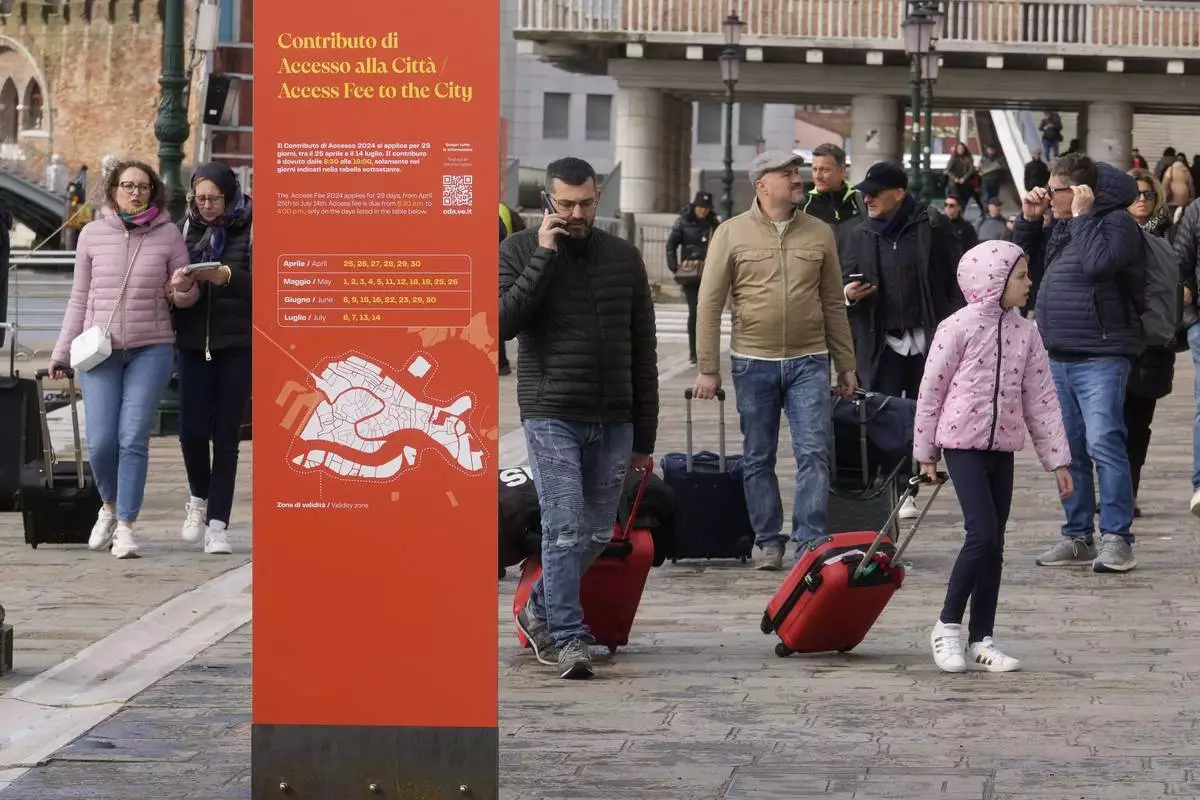
Tourists arrive in Venice, Italy, Thursday, April 25, 2024. The fragile lagoon city of Venice begins a pilot program Thursday to charge daytrippers a 5 euro entry fee that authorities hope will discourage tourists from arriving on peak days. The daytripper tax is being tested on 29 days through July, mostly weekends and holidays starting with Italy's Liberation Day holiday Thursday. Officials expect some 10,000 people will pay the fee to access the city on the first day, downloading a QR code to prove their payment, while another 70,000 will receive exceptions, for example, because they work in Venice or live in the Veneto region. (AP Photo/Luca Bruno)
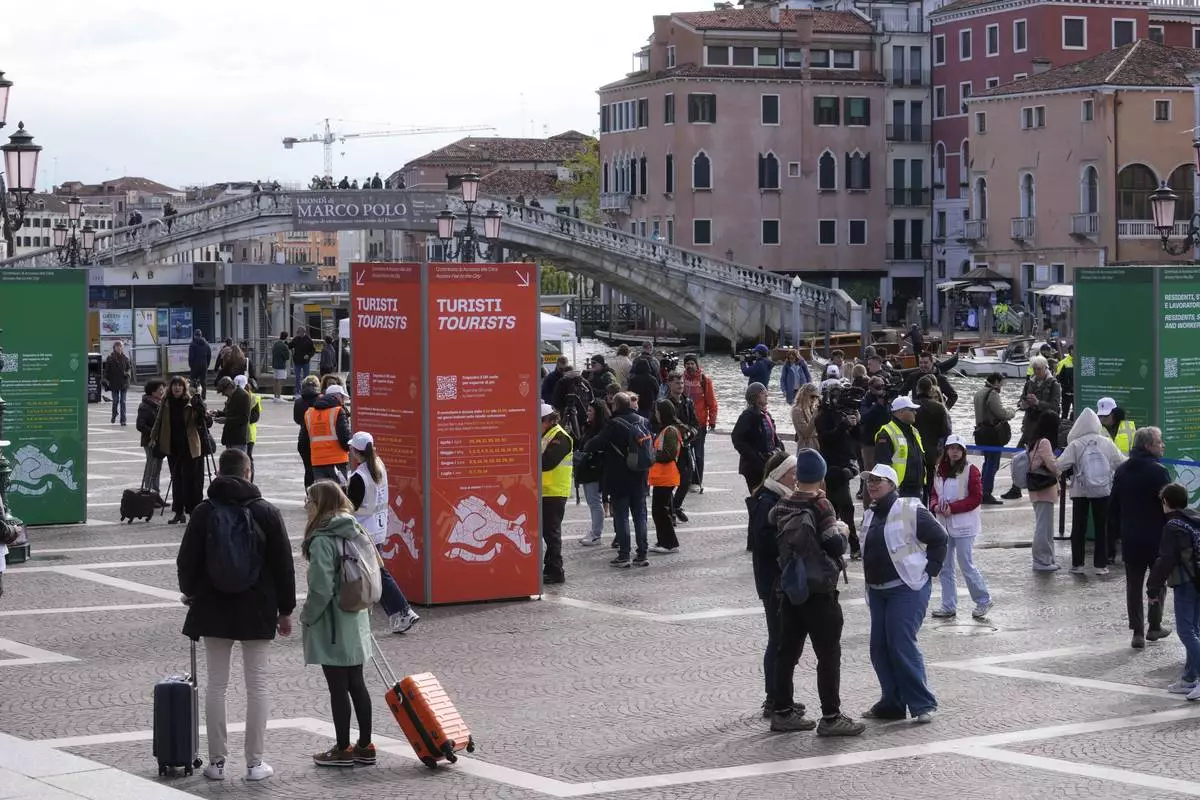
Stewards check tourists QR code access outside the main train station in Venice, Italy, Thursday, April 25, 2024. The fragile lagoon city of Venice begins a pilot program Thursday to charge daytrippers a 5 euro entry fee that authorities hope will discourage tourists from arriving on peak days. The daytripper tax is being tested on 29 days through July, mostly weekends and holidays starting with Italy's Liberation Day holiday Thursday. Officials expect some 10,000 people will pay the fee to access the city on the first day, downloading a QR code to prove their payment, while another 70,000 will receive exceptions, for example, because they work in Venice or live in the Veneto region. (AP Photo/Luca Bruno)
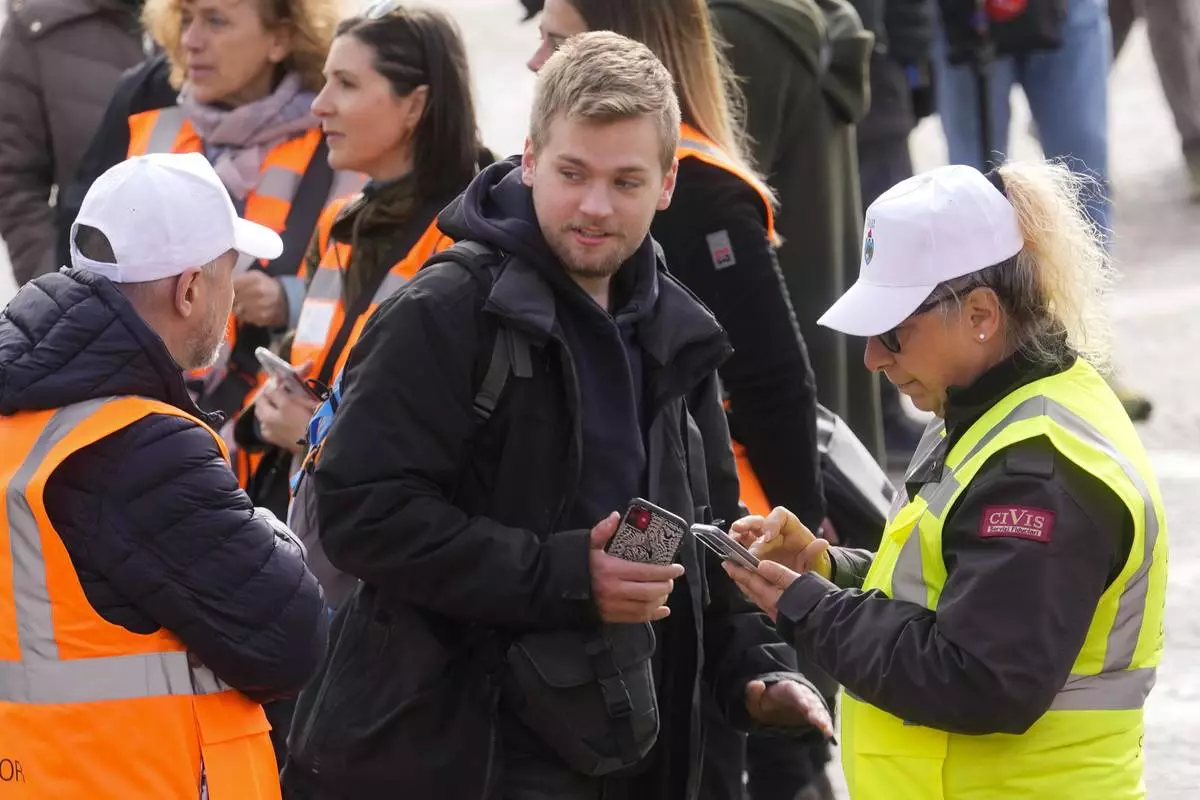
Stewards check a tourist QR code access outside the main train station in Venice, Italy, Thursday, April 25, 2024. The fragile lagoon city of Venice begins a pilot program Thursday to charge daytrippers a 5 euro entry fee that authorities hope will discourage tourists from arriving on peak days. The daytripper tax is being tested on 29 days through July, mostly weekends and holidays starting with Italy's Liberation Day holiday Thursday. Officials expect some 10,000 people will pay the fee to access the city on the first day, downloading a QR code to prove their payment, while another 70,000 will receive exceptions, for example, because they work in Venice or live in the Veneto region. (AP Photo/Luca Bruno)
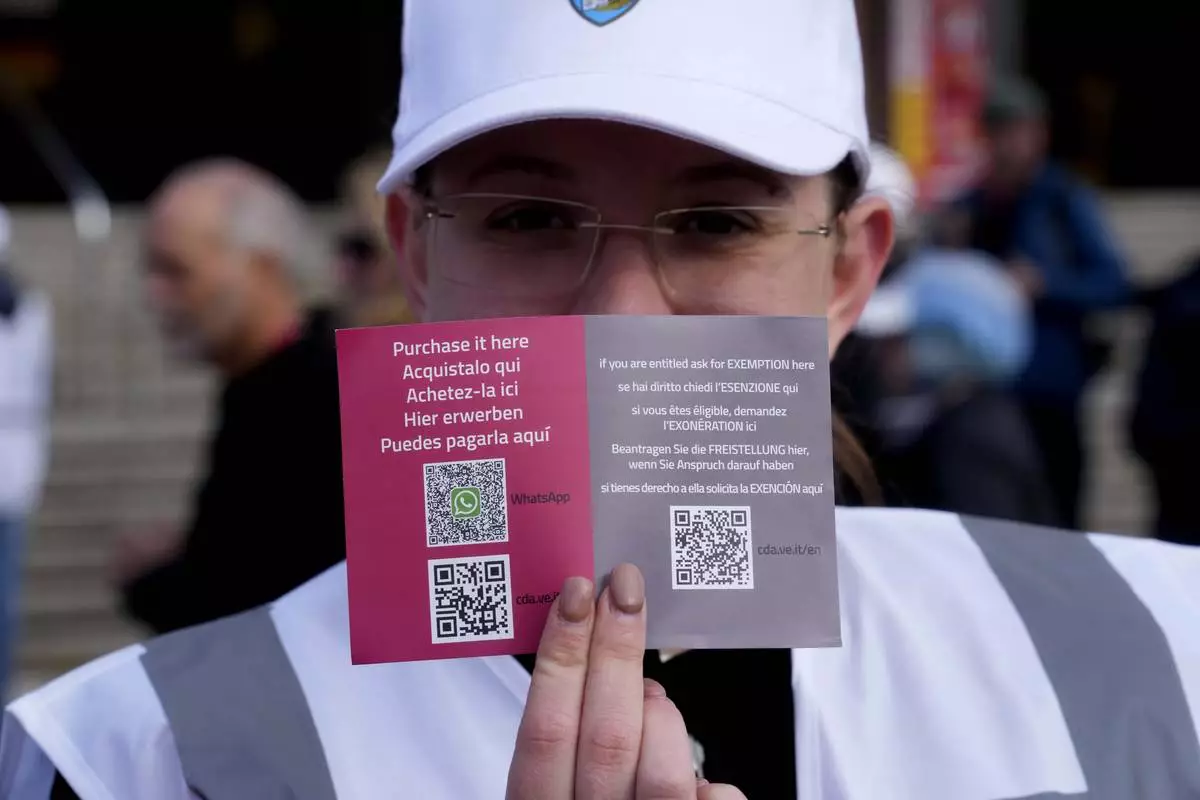
A steward shows the QR code access outside the main train station in Venice, Italy, Thursday, April 25, 2024. The fragile lagoon city of Venice begins a pilot program Thursday to charge daytrippers a 5 euro entry fee that authorities hope will discourage tourists from arriving on peak days. The daytripper tax is being tested on 29 days through July, mostly weekends and holidays starting with Italy's Liberation Day holiday Thursday. Officials expect some 10,000 people will pay the fee to access the city on the first day, downloading a QR code to prove their payment, while another 70,000 will receive exceptions, for example, because they work in Venice or live in the Veneto region. (AP Photo/Luca Bruno)
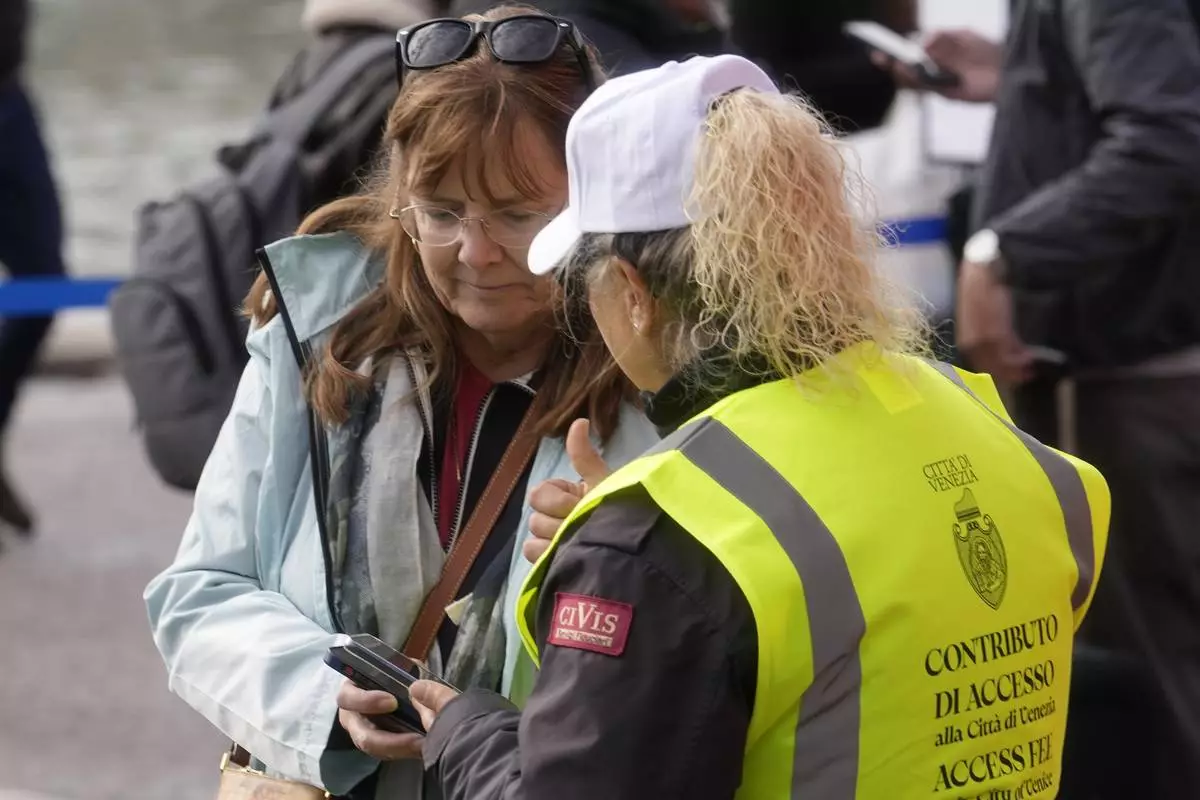
A steward checks a tourist QR code access outside the main train station in Venice, Italy, Thursday, April 25, 2024. The fragile lagoon city of Venice begins a pilot program Thursday to charge daytrippers a 5 euro entry fee that authorities hope will discourage tourists from arriving on peak days. The daytripper tax is being tested on 29 days through July, mostly weekends and holidays starting with Italy's Liberation Day holiday Thursday. Officials expect some 10,000 people will pay the fee to access the city on the first day, downloading a QR code to prove their payment, while another 70,000 will receive exceptions, for example, because they work in Venice or live in the Veneto region. (AP Photo/Luca Bruno)
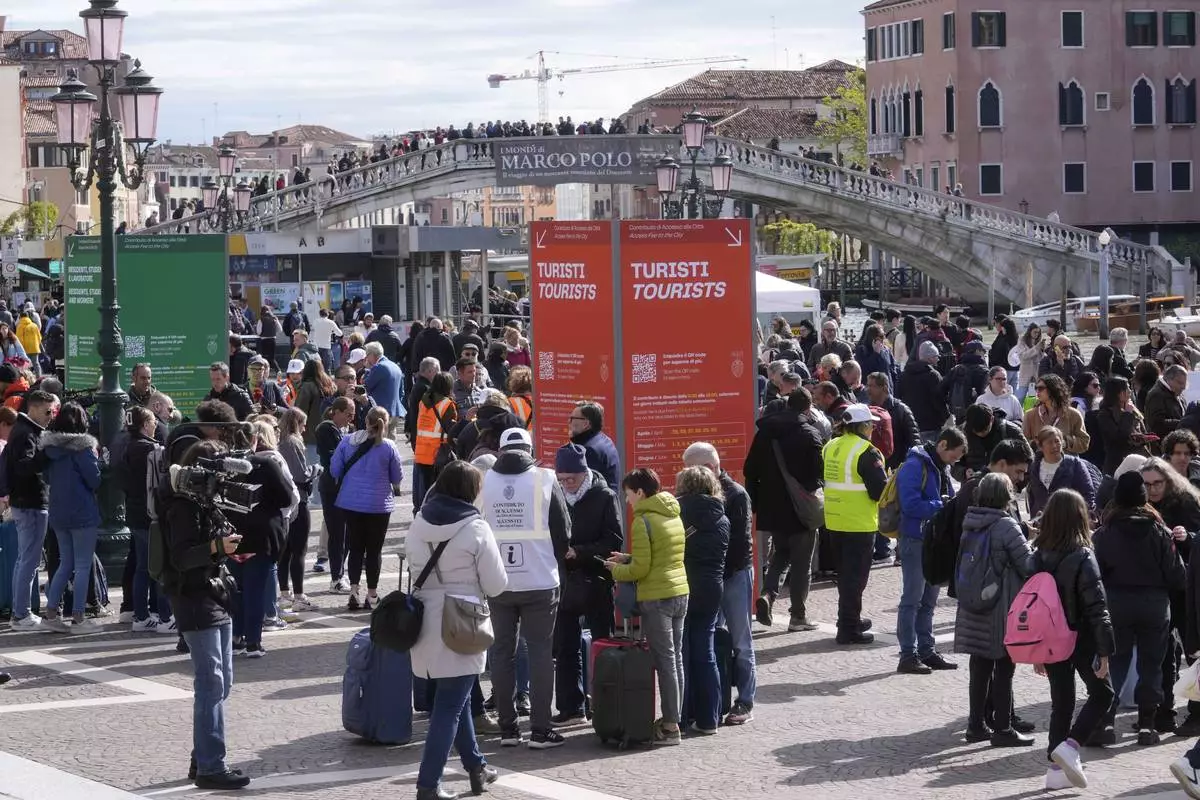
Stewards check tourists QR code access outside the main train station in Venice, Italy, Thursday, April 25, 2024. The fragile lagoon city of Venice begins a pilot program Thursday to charge daytrippers a 5 euro entry fee that authorities hope will discourage tourists from arriving on peak days. The daytripper tax is being tested on 29 days through July, mostly weekends and holidays starting with Italy's Liberation Day holiday Thursday. Officials expect some 10,000 people will pay the fee to access the city on the first day, downloading a QR code to prove their payment, while another 70,000 will receive exceptions, for example, because they work in Venice or live in the Veneto region. (AP Photo/Luca Bruno)
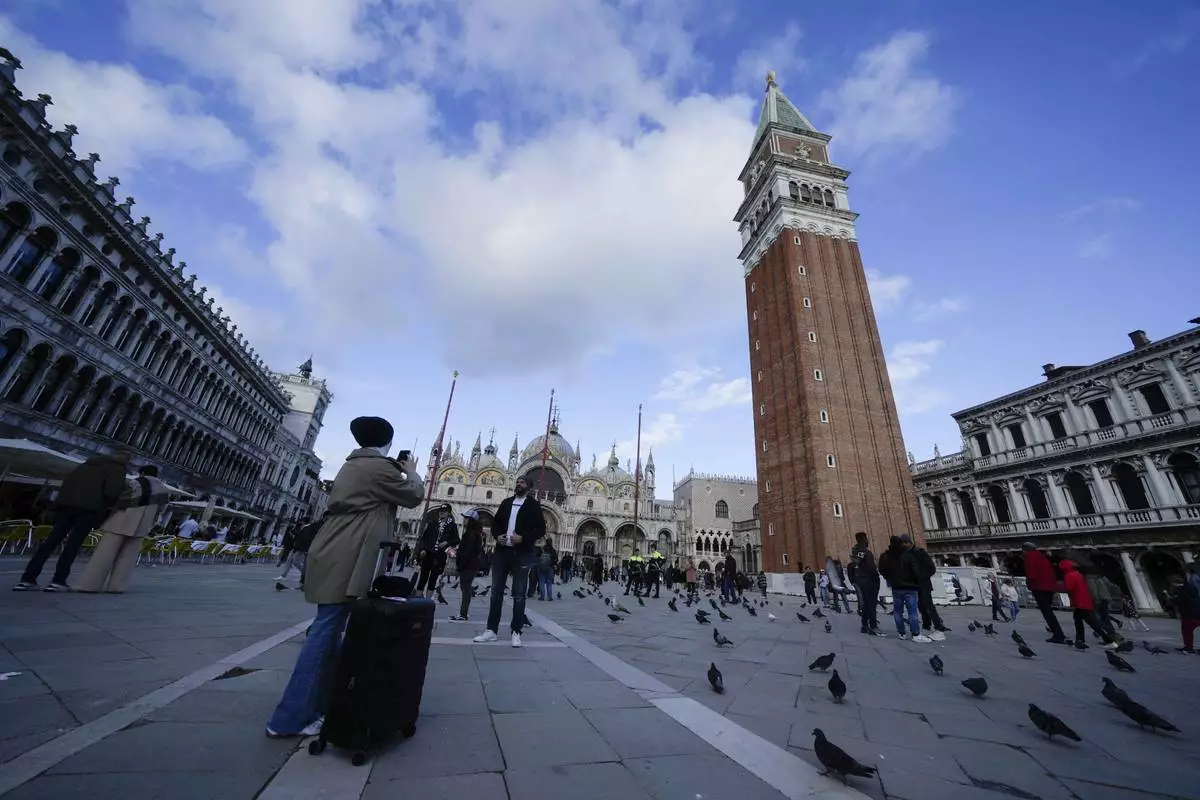
Tourists take pictures at the St. Mark square in Venice, Italy, Wednesday, April 24, 2024. The lagoon city of Venice begins a pilot program Thursday, April 25, 2024 to charge daytrippers a 5 euro entry fee that authorities hope will discourage tourists from arriving on peak days. Officials expect some 10,000 people will pay the fee to access the city on the first day, downloading a QR code to prove their payment. (AP Photo/Luca Bruno)
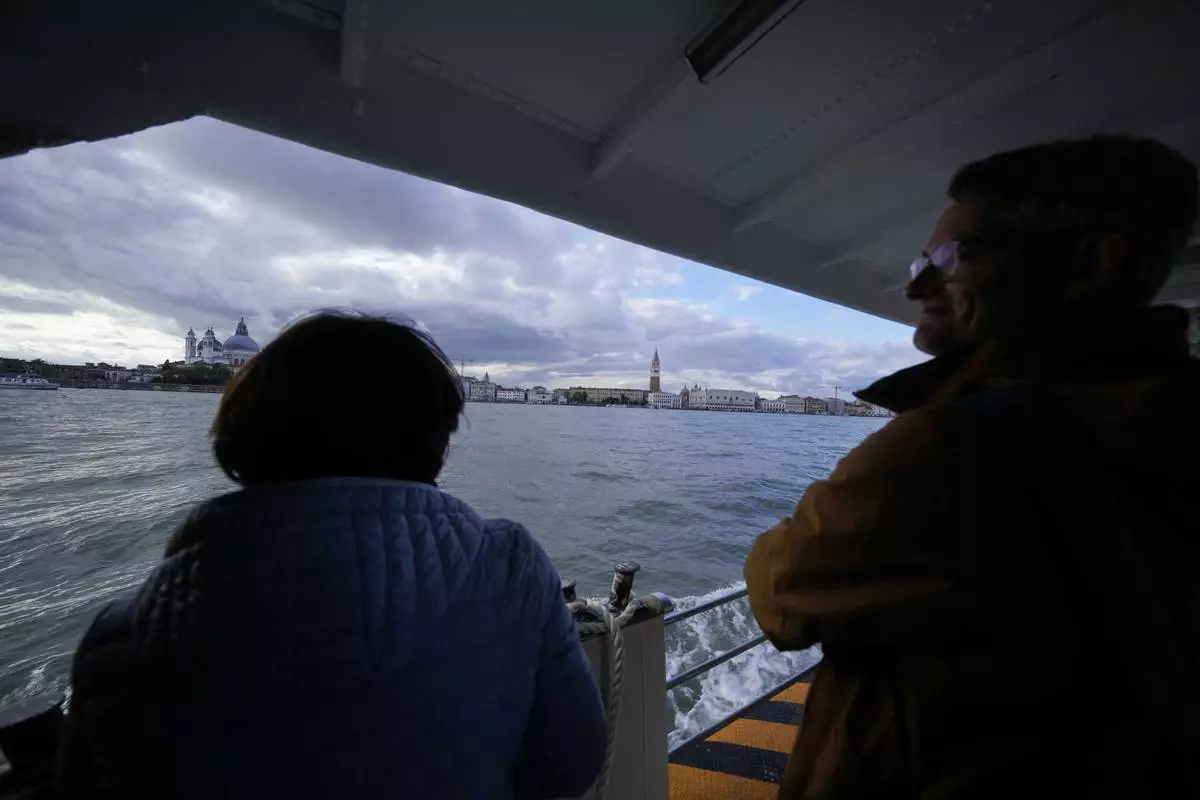
Tourists ride on a ferry boat in Venice, Italy, Wednesday, April 24, 2024. The lagoon city of Venice begins a pilot program Thursday, April 25, 2024 to charge daytrippers a 5 euro entry fee that authorities hope will discourage tourists from arriving on peak days. Officials expect some 10,000 people will pay the fee to access the city on the first day, downloading a QR code to prove their payment. (AP Photo/Luca Bruno)
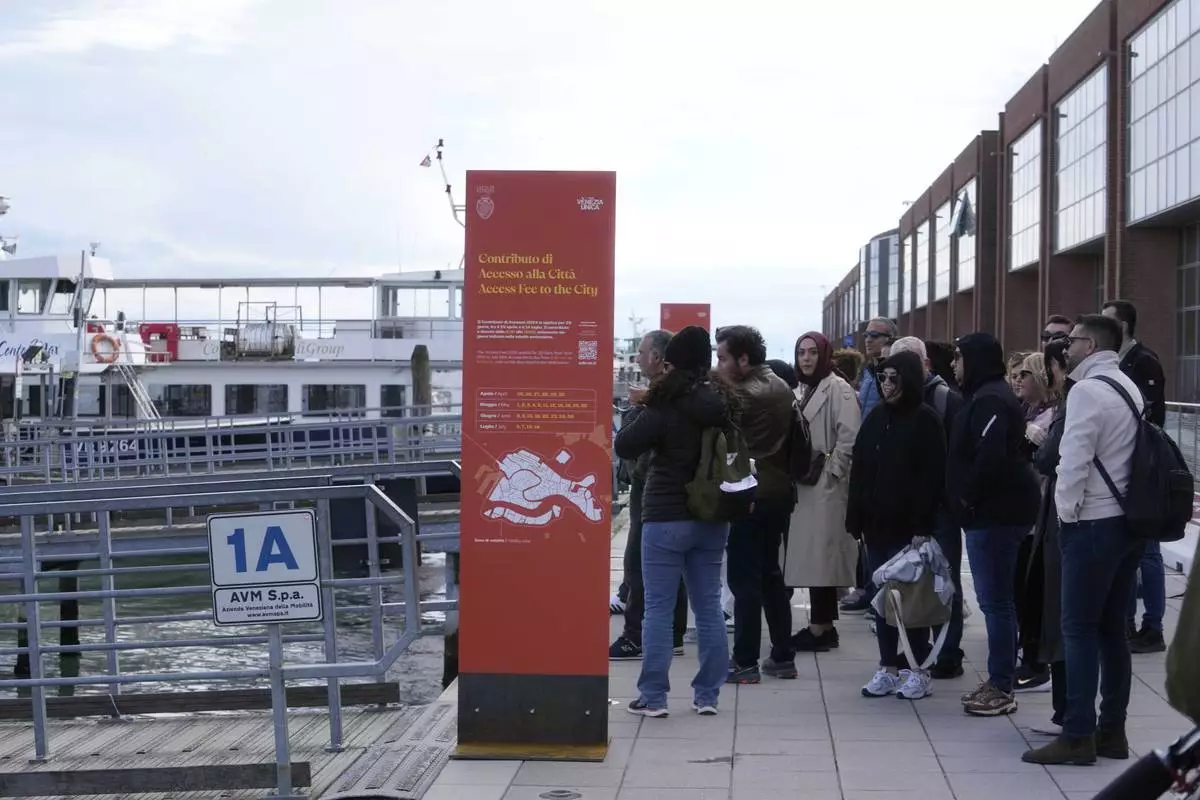
People stand in front of an information board explaining how to pay the tourist tax in Venice, Italy, Wednesday, April 24, 2024. The lagoon city of Venice begins a pilot program Thursday, April 25, 2024 to charge daytrippers a 5 euro entry fee that authorities hope will discourage tourists from arriving on peak days. Officials expect some 10,000 people will pay the fee to access the city on the first day, downloading a QR code to prove their payment. (AP Photo/Luca Bruno)
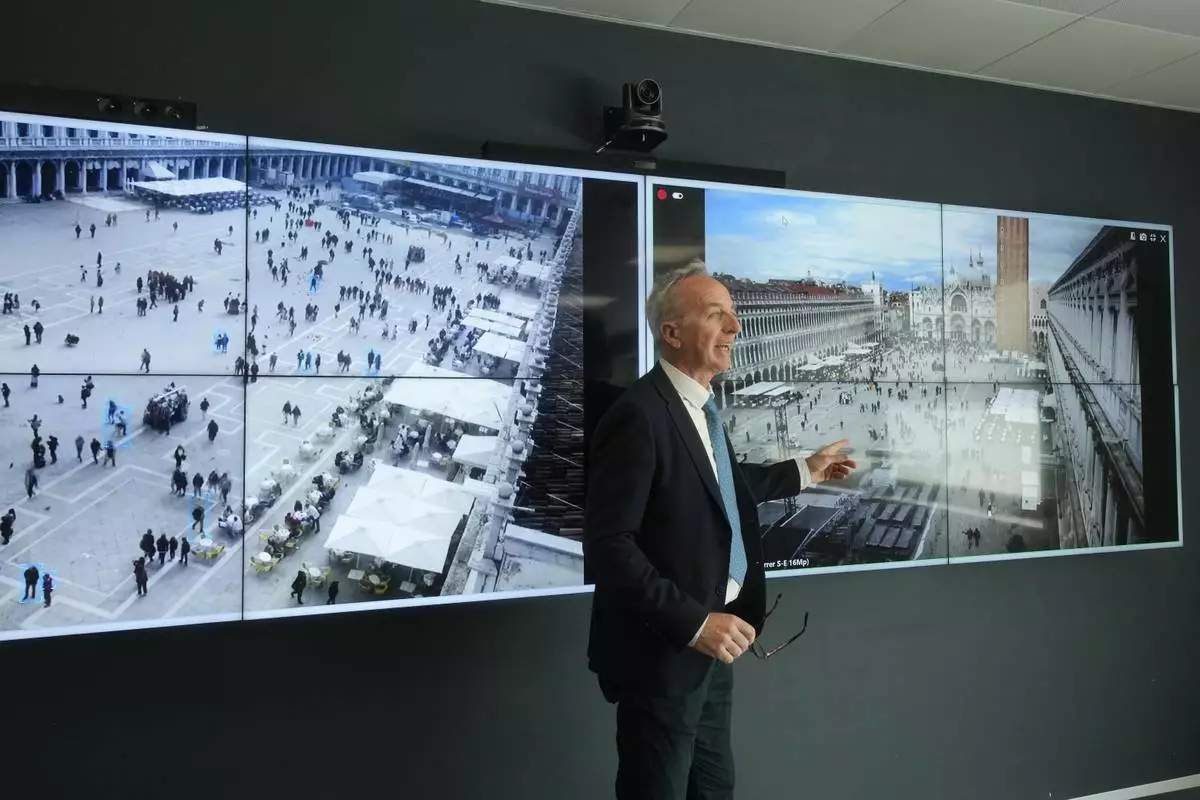
Marco Bettini, director of Venis Informatics System, gestures as he talks to reporters at the police Venice control room, in Venice, Italy, Wednesday, April 24, 2024. The lagoon city of Venice begins a pilot program Thursday, April 25, 2024 to charge daytrippers a 5 euro entry fee that authorities hope will discourage tourists from arriving on peak days. Officials expect some 10,000 people will pay the fee to access the city on the first day, downloading a QR code to prove their payment. (AP Photo/Luca Bruno)

Venice councillor Simone Venturini speaks with reporters in front of a tourist tax totem in Venice, Italy, Wednesday, April 24, 2024. The lagoon city of Venice begins a pilot program Thursday, April 25, 2024 to charge daytrippers a 5 euro entry fee that authorities hope will discourage tourists from arriving on peak days. Officials expect some 10,000 people will pay the fee to access the city on the first day, downloading a QR code to prove their payment. (AP Photo/Luca Bruno)
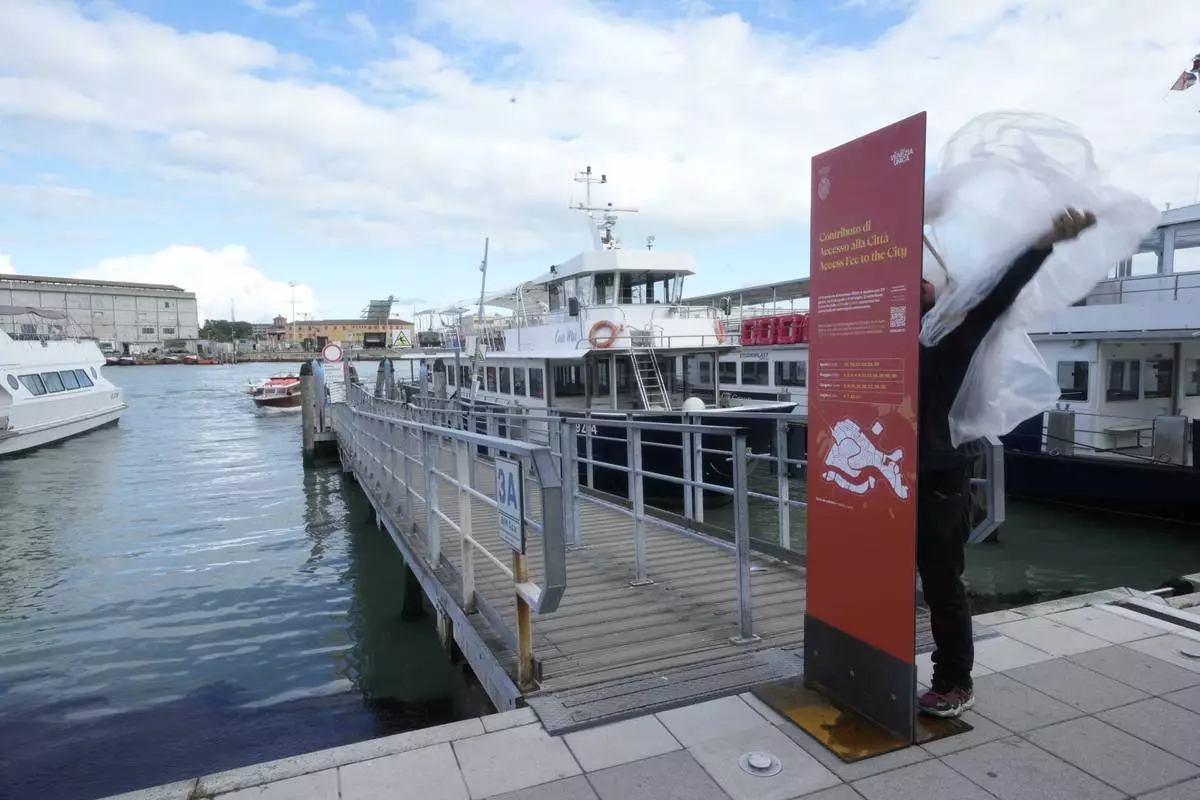
Workers prepare banner explaining how to pay the tourist tax in Venice, Italy, Wednesday, April 24, 2024. The lagoon city of Venice begins a pilot program Thursday, April 25, 2024 to charge daytrippers a 5 euro entry fee that authorities hope will discourage tourists from arriving on peak days. Officials expect some 10,000 people will pay the fee to access the city on the first day, downloading a QR code to prove their payment. (AP Photo/Luca Bruno)

Marco Bettini, director of Venis Informatics System, gestures as he explains the Venice density to reporters at the police Venice control room in Venice, Italy, Wednesday, April 24, 2024. The lagoon city of Venice begins a pilot program Thursday, April 25, 2024 to charge daytrippers a 5 euro entry fee that authorities hope will discourage tourists from arriving on peak days. Officials expect some 10,000 people will pay the fee to access the city on the first day, downloading a QR code to prove their payment. (AP Photo/Luca Bruno)
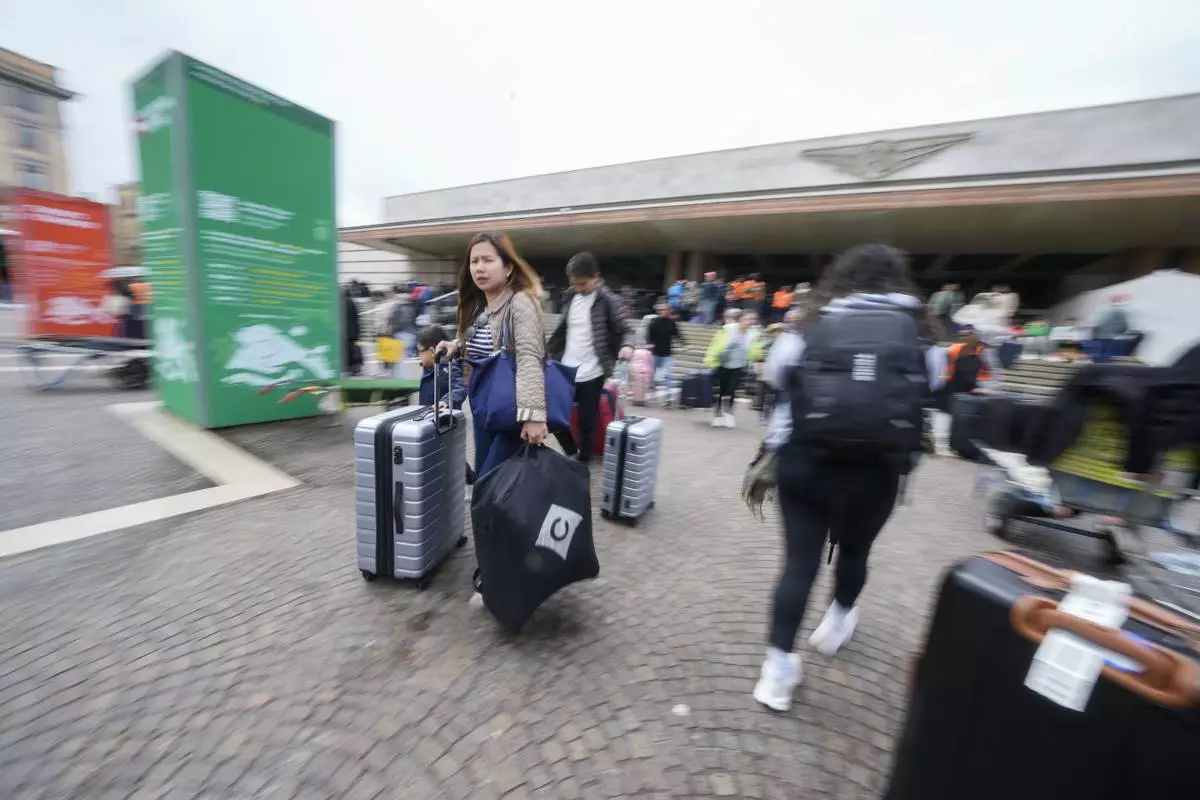
Tourists arrive at the main train station in Venice, Italy, Wednesday, April 24, 2024. The lagoon city of Venice begins a pilot program Thursday, April 25, 2024 to charge daytrippers a 5 euro entry fee that authorities hope will discourage tourists from arriving on peak days. Officials expect some 10,000 people will pay the fee to access the city on the first day, downloading a QR code to prove their payment. (AP Photo/Luca Bruno)
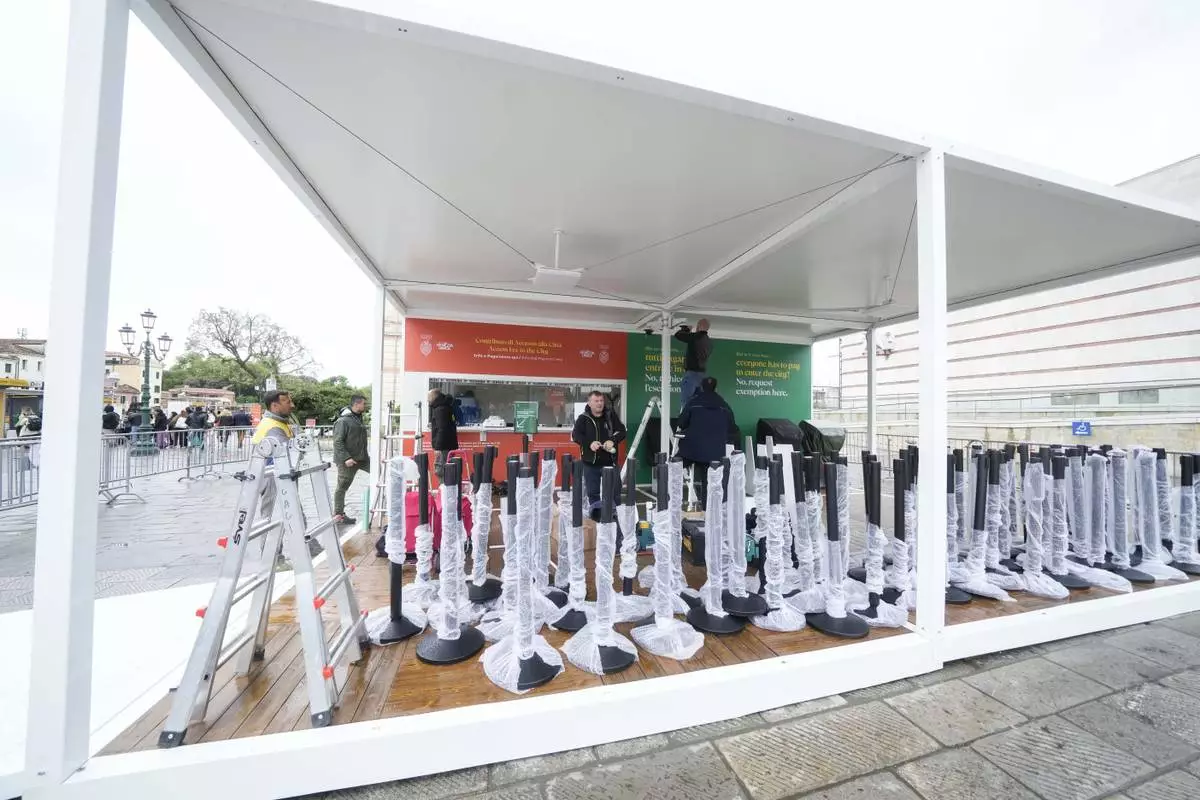
Workers prepare the tourist tax cashier desks outside the main train station in Venice, Italy, Wednesday, April 24, 2024. The lagoon city of Venice begins a pilot program Thursday, April 25, 2024 to charge daytrippers a 5 euro entry fee that authorities hope will discourage tourists from arriving on peak days. Officials expect some 10,000 people will pay the fee to access the city on the first day, downloading a QR code to prove their payment. (AP Photo/Luca Bruno)
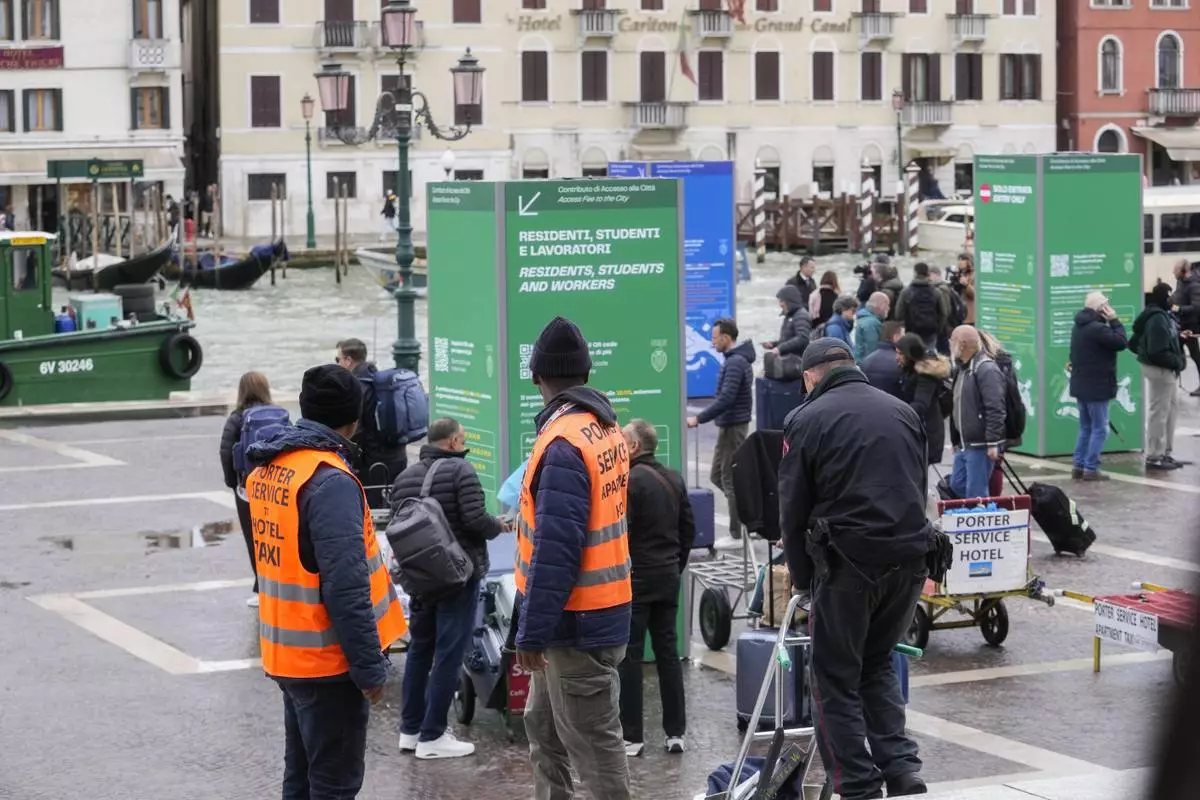
Porters wait for tourists outside the main train station in Venice, Italy, Wednesday, April 24, 2024. The lagoon city of Venice begins a pilot program Thursday, April 25, 2024 to charge daytrippers a 5 euro entry fee that authorities hope will discourage tourists from arriving on peak days. Officials expect some 10,000 people will pay the fee to access the city on the first day, downloading a QR code to prove their payment. (AP Photo/Luca Bruno)
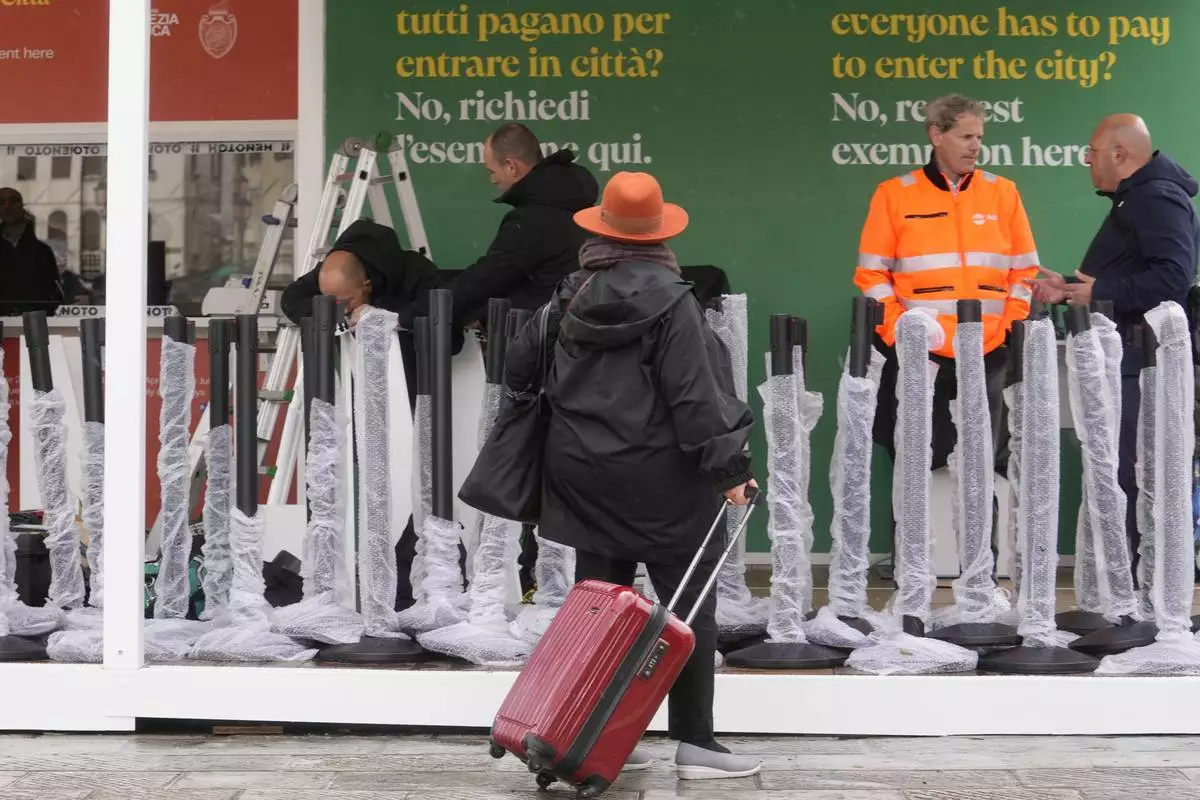
Workers prepare the tourist tax cashier desks outside the main train station in Venice, Italy, Wednesday, April 24, 2024. The lagoon city of Venice begins a pilot program Thursday, April 25, 2024 to charge daytrippers a 5 euro entry fee that authorities hope will discourage tourists from arriving on peak days. Officials expect some 10,000 people will pay the fee to access the city on the first day, downloading a QR code to prove their payment. (AP Photo/Luca Bruno)
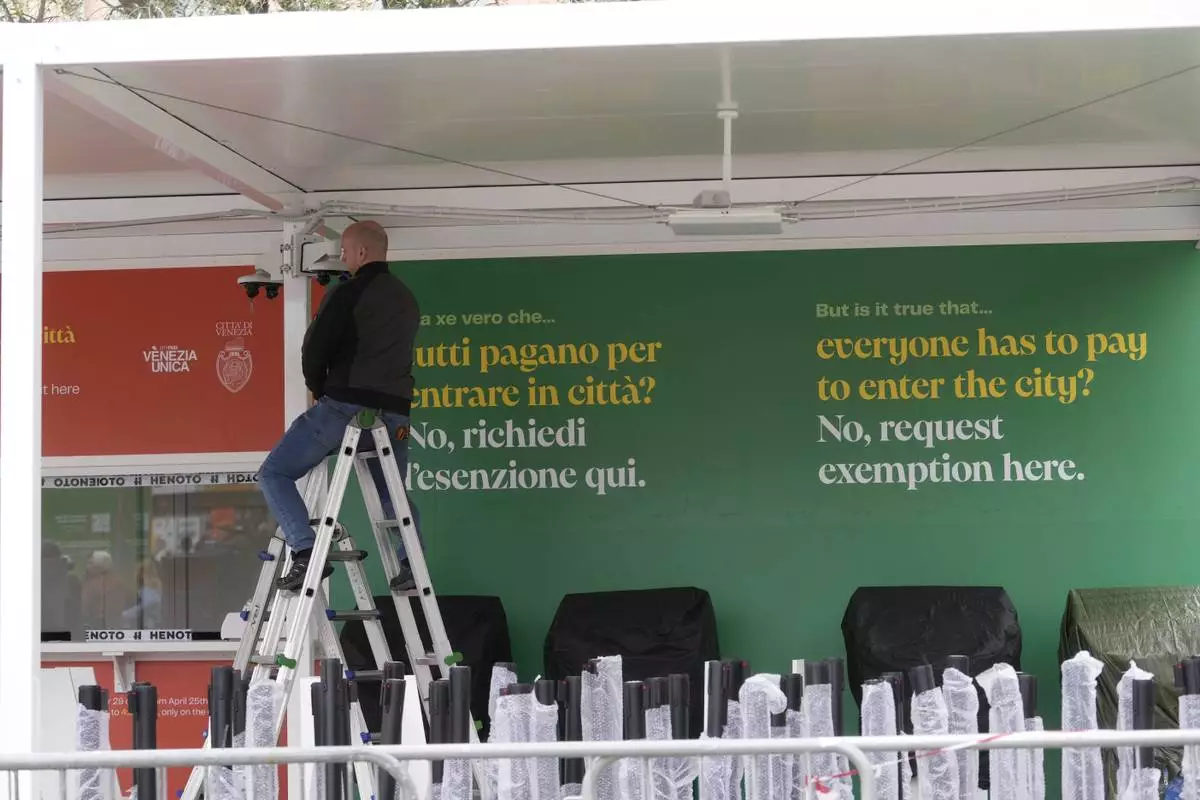
Workers prepare the tourist tax cashier desks outside the main train station in Venice, Italy, Wednesday, April 24, 2024. The lagoon city of Venice begins a pilot program Thursday, April 25, 2024 to charge daytrippers a 5 euro entry fee that authorities hope will discourage tourists from arriving on peak days. Officials expect some 10,000 people will pay the fee to access the city on the first day, downloading a QR code to prove their payment. (AP Photo/Luca Bruno)

Porters wait for tourists outside the main train station in Venice, Italy, Wednesday, April 24, 2024. The lagoon city of Venice begins a pilot program Thursday, April 25, 2024 to charge daytrippers a 5 euro entry fee that authorities hope will discourage tourists from arriving on peak days. Officials expect some 10,000 people will pay the fee to access the city on the first day, downloading a QR code to prove their payment. (AP Photo/Luca Bruno)
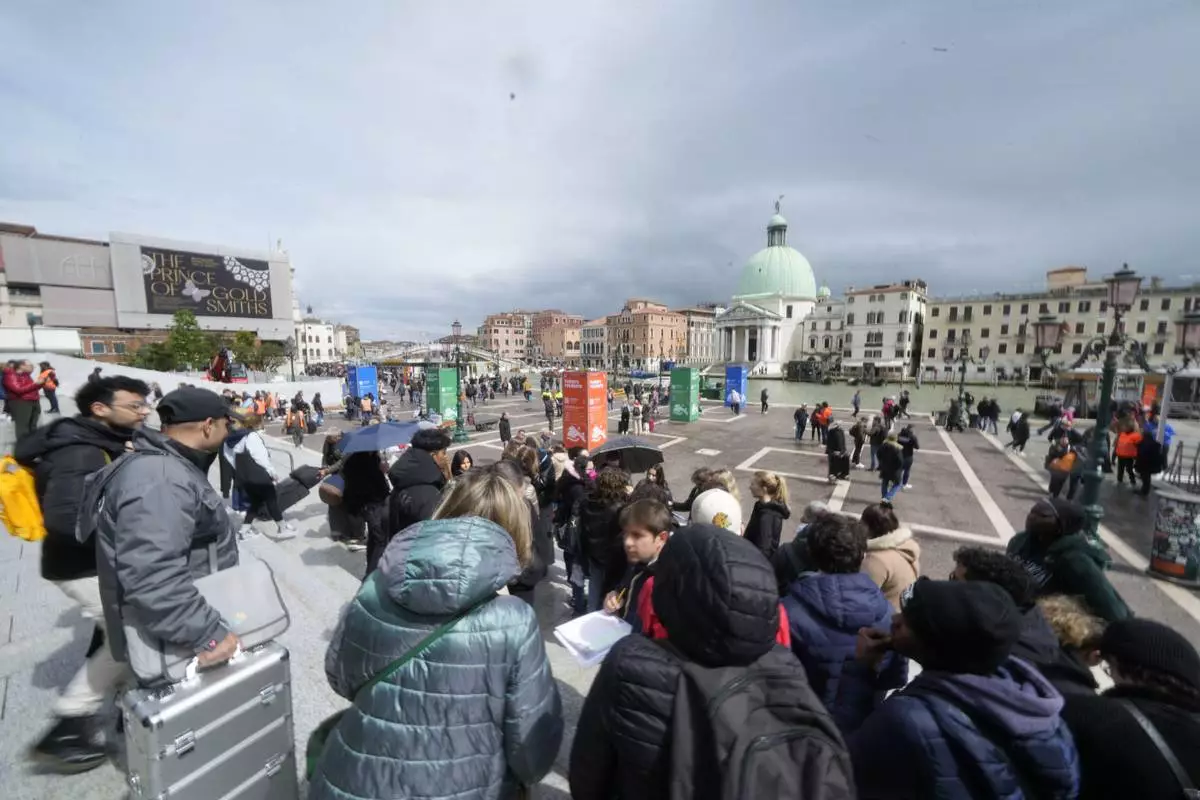
Tourists arrive outside the main train station in Venice, Italy, Wednesday, April 24, 2024. The lagoon city of Venice begins a pilot program Thursday, April 25, 2024 to charge daytrippers a 5 euro entry fee that authorities hope will discourage tourists from arriving on peak days. Officials expect some 10,000 people will pay the fee to access the city on the first day, downloading a QR code to prove their payment. (AP Photo/Luca Bruno)
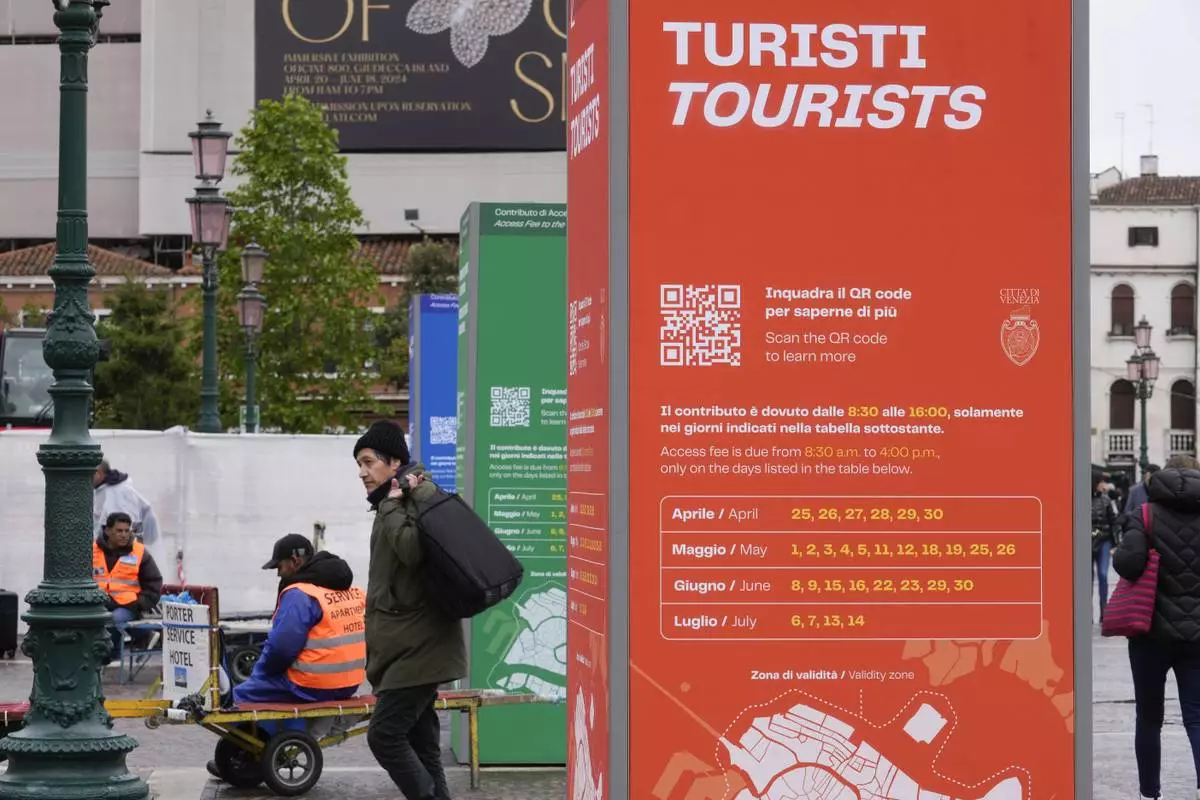
Tourist information boards are seen outside the main train station in Venice, Italy, Wednesday, April 24, 2024. The lagoon city of Venice begins a pilot program Thursday, April 25, 2024 to charge daytrippers a 5 euro entry fee that authorities hope will discourage tourists from arriving on peak days. Officials expect some 10,000 people will pay the fee to access the city on the first day, downloading a QR code to prove their payment. (AP Photo/Luca Bruno)
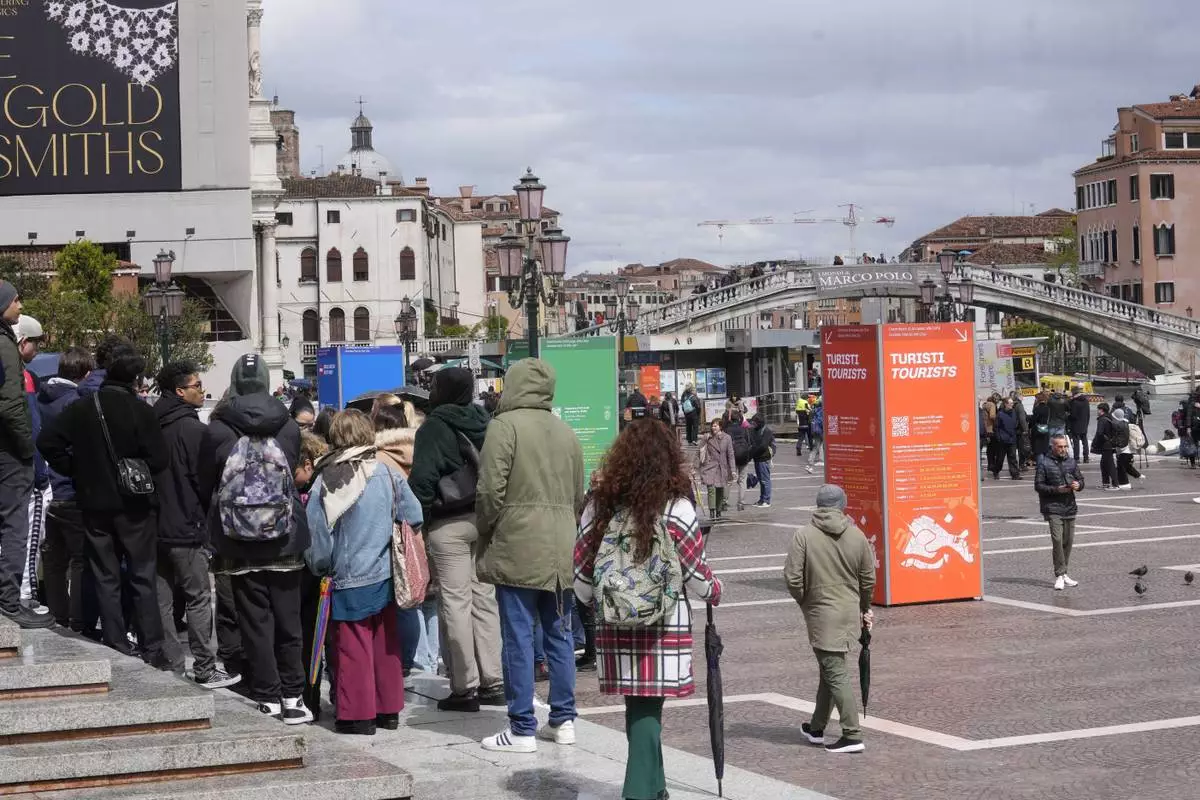
Tourists arrive outside the main train station in Venice, Italy, Wednesday, April 24, 2024. The lagoon city of Venice begins a pilot program Thursday, April 25, 2024 to charge daytrippers a 5 euro entry fee that authorities hope will discourage tourists from arriving on peak days. Officials expect some 10,000 people will pay the fee to access the city on the first day, downloading a QR code to prove their payment. (AP Photo/Luca Bruno)




































